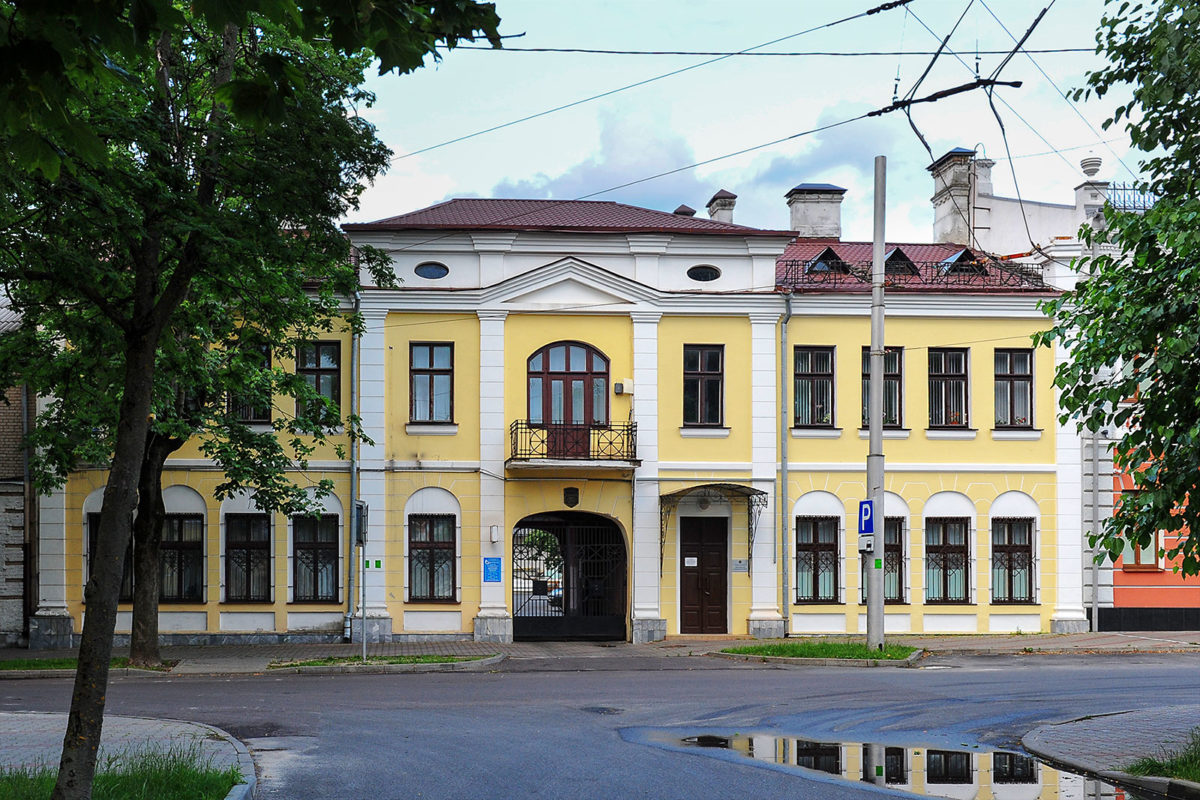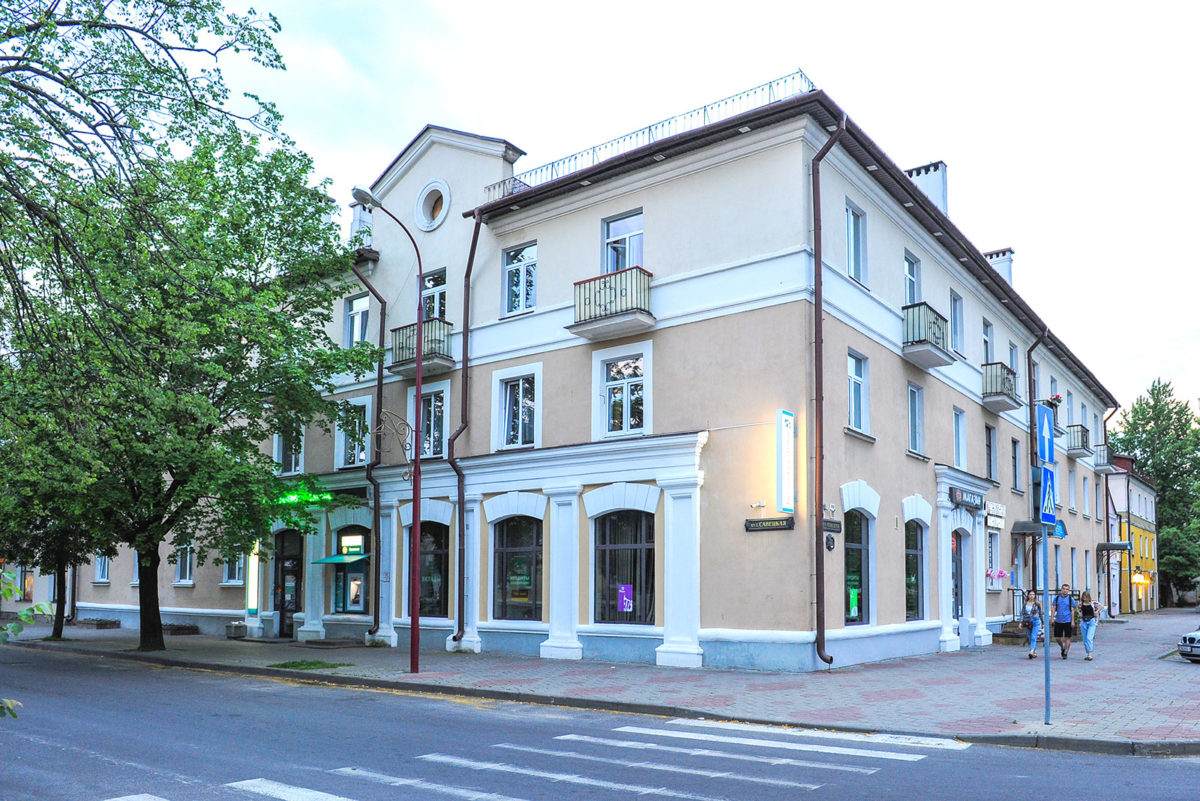Jewish cemetery
When the Soviet air raids began, the invaders installed twenty-four-hour sound detectors. They placed them at the Jewish cemetery. Dug outs were built for the team, maintaining the equipment in the west part of the cemetery amongst the graves. Matzevahs from this site had been trucked out. Their fragments — large or small — with characteristic, easily recognizable writings were being found later in different places in the city. During one of the air raids the German sound detector was hit and turned into scrap iron. The scrap iron was rusting for a long time in the post-war years.
The oldest Brest synagogue
Sovetskaya Street
The 40–50s years of the last century. Sovetskaya Street. The “1-go Maya” cinema (it was called “Adria” in the Polish times). Next to it is the oldest pictorial photograph building, which remembered the pre-war times. The pictorial photograph building and the nearby house being under construction have not survived. The cinema closed in the 90s.
Pushkinskaya Street
Mitskevicha Street
Brest, July 15 or July 16, 1945. When Stalin was traveling to the Potsdam Conference emergency precautions were taken to guard the station, the station forecourt, and the train tracks. The first line of the cordon passed along Mitskevicha Street, the second line passed along Ordzhonikidze Street. The soldiers did not allow anyone to approach the station. The authorities cleared the station from passengers, only a few station workers remained there. The picture of a normal, everyday life of Brest Central Station was staged. The staff of the Ministry of State Security acted as passengers and porters carrying hand luggage. The station buffet, filled with products sold at long-forgotten pre-war prices (not at commercially over-expensive prices) remained open. The rumours about this fact quickly reached the population and were hotly discussed by the residents of Brest rather than the passage of Stalin through the city. Everyone wanted to get to the station to shop cheaply. The authorities tried in every possible way to stop those rumours, “slanderers” were threatened to be imprisoned. I’m not aware if the supreme leader had ever been looking out of the window, but he had never left the carriage, and didn’t stay in Brest for a long time. The carriage shift was not required since a wide gauge had been laid all the way to Berlin. An hour and a half later the train left. The cordon was lifted and people spread different ways to their homes, not knowing the reason for their detention.
The intersection of Belostokskaya Street and Teatralnaya Street
The intersection of Belostokskaya Street (Bialastockiej, now Sovetskikh Pogranichnikov Street) and Teatralnaya Street (Teatralnej, now Sverdlova Street). The nightly equine patrol departure from the yard of the Polish Security Service building (dyfenzywy*) for the night watch. The performance is fascinating: the armed horsemen with burning torches, the clatter of horseshoes. The regulars of the Sarver Theater (the Sarver cinema), where the restaurant used to be, had an opportunity to admire the performance. Opposite the theater in the shade of a chestnut tree, there was a chain of horse-drawn cabs for those who were having fun.
After 1939, the Sarver cinema was turned into a cinema-theater named after Gorky. Like before, there were cab drivers on the street and there was a buffet inside the building (albeit, it was a Soviet buffet). From 1944, the Gorky Cinema-Theater reopened and was working until 1946, when it was closed. The cinema “Smena” took its site. The new cinema facility on Karl Marx Street opened inside the former Lutheran church.
The city market
The city market — “the Small Market” — as it was called by the residents of Brest, who remembered its name from the pre-war times. The picture shows the market as it looked in the early 50s of the last century. Nearly always closed trading stalls bordering the corner of Kujbysheva Street and Shkolnyj Lane were still there. Nearby there was a wooden building with a workshop, where the local “handy men” were doing minor mechanical repair works, including Primus stoves repair. The city flea market was moved to the grass-green wasteland with many well-trodden paths which replaced the burnt-down quarter. The place was surrounded by a high fence. For the residents, it was like a manufactured goods department of a “bazaar supermarket”. Before the market was moved from there the sellers and buyers of all sorts of things had crowded at the intersection of Mitskevicha and Kujbysheva Streets, often blocking it completely. One could come to the flea market naked and leave it dressed from head to toe in everything new or worn depending on the thickness of the bundle of notes in a buyer’s hand. The only city department store and a handful manufactured goods shops could not compete with the flea market in either pricing or the variety of supplies. Over the years the market square became a bus station, and the market switched to the wasteland from Karbysheva Street to Kujbysheva Street facing Pushkinskaya Street. After multiple reconstructions, it has finally taken the appearance familiar to new generations of Brest residents.
“Goluboj Dunaj”
“Goluboj Dunaj” (Blue Danube) — popular drinking den of the 50s. It stood at the corner of Sovetskaya and Mitskevicha Streets on the site cleared from the corner house destroyed in 1944. At that time, bomb splinters damaged a near-by church fence. Their traces are still visible. The drinking den was colored blue which explains its nick-name given to it by the student of the Department of languages and literature Leonid Makarenko, an admirer of J. Strauss.
Former synagogue
Brest, October 1944. A military mobile film projector device is demonstrating the American film “The Big Waltz” in the building of the former synagogue. In 1945–1946, there were three cinema houses in Brest: the “1-go Maya” cinema (the former “Adria” on Sovetskaya Street), the “Smena” cinema (the former Evangelical Church on Karl Marx Street), and the “Named after Gorky” cinema (the former cinema of Sarvera on Sverdlova Street). The hall of the synagogue was spacious. There was a stage and curtains, and both local and touring performances were shown there. Various solemn assemblies, meetings of the pioneer druzhinas and Komsomol members of the city, performances of professional and amateur actors were also held in the building. Later on the cinema “Belarus” was opened in the former synagogue building.









